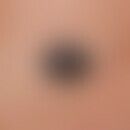Synonym(s)
Macula; macule; macules; patch; Patches; Spots
DefinitionThis section has been translated automatically.
Sharply or indistinctly circumscribed lesion of variable size and shape, contrasting in color to the surrounding area, not palpable. Spots may be acquired or congenital. They may be primary or secondary to another skin disease or its healing.
In Anglo-American literature, patches are further divided into "macule" < 1.0 cm and"patch" > 1.0 cm. In the following, both terms are used synonymously. However, this distinction may be made in descriptions of findings.
ClassificationThis section has been translated automatically.
- Dark spot (yellow, green, red, blue, brown, black):
- Dye retention, melanin, haemosiderin, carotene, bile pigment or foreign substances: coal, powder, tar, bismuth, silver, gold, etc.
- Increased vascular filling
- Proliferated vascular system, e.g. naevus flammeus.
- Bright spot:
- Pigmentation reduced or completely absent: pityriasis alba, leukoderm, vitiligo
- Constricted blood vessels: e.g. in digitus mortuus, steroid skin
- Disturbed blood vessel dynamics: e.g. naevus anaemicus.
EtiologyThis section has been translated automatically.
- Dark spot (yellow, green, red, blue, brown, black):
- Dye storage, melanin, hemosiderin, carotene, bile pigment or foreign substances: coal, powder, tar, bismuth, silver, gold and others.
- Increased vascular filling
- Increased vascularization, e.g. nevus flammeus.
- In red spots, the distinction between anemizable and nonanemizable spots is useful for differential diagnostic considerations. A non-anemizable red spot, occurs (apart from a red tattoo), due to an accumulation of blood in the dermis. An anemizable spot, on the other hand, an erythema, results exclusively from (inflammatory)dilatation of the dermal vessels.
- A dark (not red) spot presents as a contrast to the surrounding area and is only perceptible as such. A clearly emerging lentigo maligna is easy to diagnose as a morphological pattern, because the brown-black spot appears as a prominent feature in otherwise normal surroundings. It becomes difficult with skin discoloration uniformly affecting the entire integument. A generalized yellow coloration will be recognized immediately in good light, because the color yellow is a non-physiological coloration. It is different with the physiologically occurring color, e.g. brown. A generalized brown spot, such as in Addison's disease, in which a homogeneous brown discoloration of the skin occurs, will not initially be perceived as such in purely morphological terms. The initial diagnosis may be "healthy sun tan". Here, only the anamnestic data will guide further.
- Light spot:
- Pigmentation diminished: depigmentation, leukoderm.
- Constricted blood vessels: e.g. in digitus mortuus, steroid skin
- Disturbed blood vessel dynamics: e.g. nevus anaemicus.
- A bright spot forms as a contrast to the surrounding area. If there is a loss of pigment cells or their dysfunction in circumscribed areas of the skin, a light spot appears in the surrounding healthy skin. If islands of unchanged healthy skin remain as "nappes claires" in surrounding pathologically reddened skin (e.g. nappes claires in erythroderma), these islands of healthy skin are interpreted as apparently pathological bright spots although they are unchanged skin. A similar mechanism can be observed in psoriasis healed after dithranol treatment. The formerly lesional skin stands out as a light patch to the surrounding area pigmented by dithranol. Again, the change takes place in the surrounding skin (brown coloration of the horny layer).
- A universal light spot of the skin as in the various forms of albinism or in extensive vitiligo will not be perceived as a light spot because the demarcation to the normal skin is missing. Thus, even in extensive vitiligo, it is not the bright spot as such that is disturbing, but the often bizarre islands of normally pigmented or repigmented skin.
- Basically, the following scenarios for a bright spot can be derived: Bright spots result either from a circumscribed disturbance of blood vessel dynamics due to vasoconstriction (nevus anaemicus) or from a reduction or complete absence of pigment cells (depigmented scar) or as a negative contrast in a color-altered environment (dithranol discoloration in psoriasis treatment).
- A final possibility of light discoloration occurs in sclerotic skin lesions. Superficial sclerosis of the dermis leads to a milky glass effect; existing vessels are rarefied, deeper vessels cannot show through the sclerotic layer, so that a white effect occurs (e.g. lichen sclerosus et atrophicus).
LiteratureThis section has been translated automatically.
- Altmeyer P (2007) Dermatological differential diagnosis. The way to clinical diagnosis. Springer Medicine Publishing House, Heidelberg
- Nast A, Griffiths CE, Hay R, Sterry W, Bolognia JL. The 2016 International League of Dermatological Societies' revised glossary for the description of cutaneous lesions. Br J Dermatol. 174:1351-1358.
Ochsendorf F et al (2017) Examination procedure and theory of efflorescence. Dermatologist 68: 229-242







